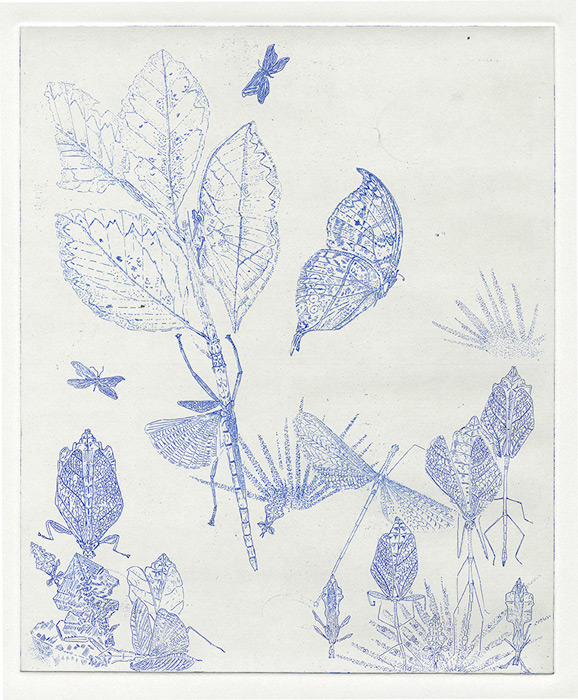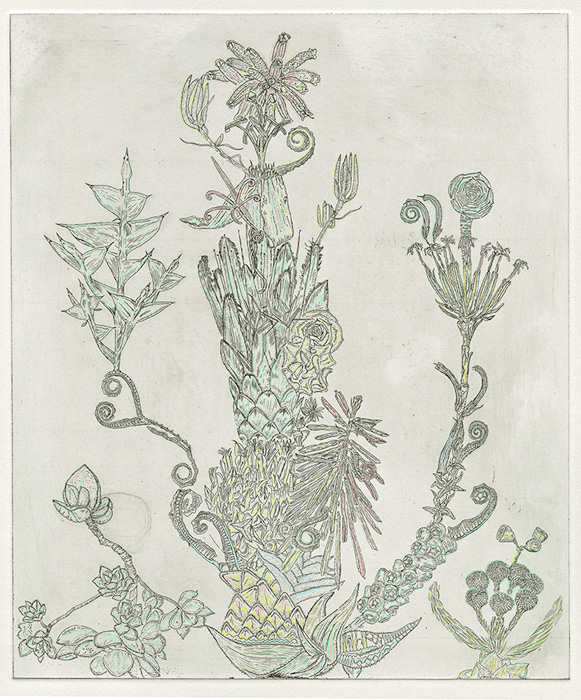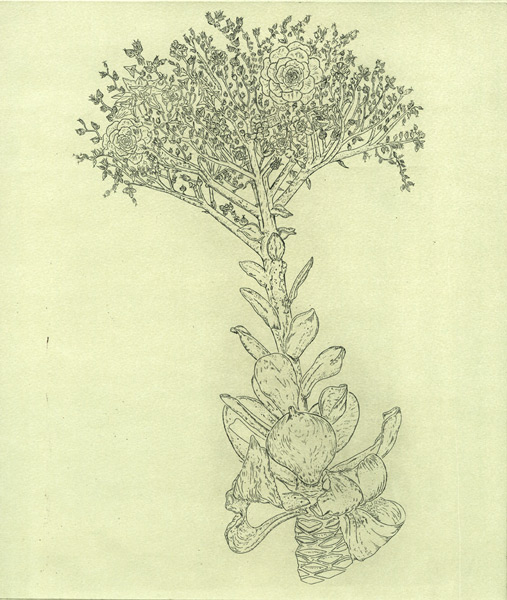NHM and Big Draw Workshop ‘Experimenting with observational drawing and algorithm in response to natural form’ by Gemma Anderson and William Latham. Event listing here.
This workshop brought Anderson and Latham’s experimental drawing methods together, inviting members of the public to participate in their creative processes and to share in their inspiration. By using Anderson’s drawing method, participants were encouraged to explore the ways in which biological forms evolve.
Both Anderson and Latham were inspired by the Natural History museum’s collections while they were studying Printmaking at the Royal College of Art, 20 years apart! (Latham 1983-1985, Anderson 2005-2007).
Anderson has been inspired by Latham’s FormSynth; a rule based (algorithm) evolutionary drawing method and created a new version of the method called ‘Isomorphogenesis’ which maintains continual observational contact with the NHM collections.

(Leaf Form, Copper Etching) by Gemma Anderson
Preparations for the workshop:
Since 2011 Anderson has been drawing from the NHM collections: zoological, botanical, paleontological, molluscs, mineral amongst others. Through this process she has built collaborative relationships with many curators and identified specimens with interesting morphology: the forms and symmetries of Isomorphology www.isomorphology.com
This free workshop based in the AMC offered members of the public the opportunity to engage with specimens that are otherwise hidden in the museum collections.
Anderson asked a number of curators in advance of the workshop to loan specimens for the group to observe (James McClaine loaned puffer fish/ Jacek loaned plants, peter Tandy loaned minerals, Jill Darell loaned corals and Andreia loaned shells) Gavin Broad (senior curator in Entomology) liaised with each curator inside the museum and brought the specimens to the AMC on the day.

(Goethe Primal Plant, Copper Etching) by Gemma Anderson
Sunday the 19th October: On the day…
The group (an interesting mix of mathematicians, psychiatrists, RCA students, NHM scientists and the editor of new scientist!) arrived at the AMC at 11am. Anderson and Latham introduced themselves and the workshop and Gavin broad gave an introduction to handling the collections. Gavin then gave us a tour of the hymenoptera (one of the largest orders of insects) on the 3rd floor of the Darwin center. We discussed how the collections are classified and how new species are described.
We explored how an artist (Anderson) and a scientist and curator (Broad) approached the museum collections. Anderson introduced her PhD research on ‘Isomorphology’ as an alternative approach to classifying the collections and reported on different ways of knowing in artistic and scientific fieldwork. The tour ended with a general discussion and the group asked some interesting questions about ways of describing and naming new species…
‘Gemma and Gavin worked very well together to engage the group- this day will be very memorable!’ Florence Sweeney, Drawing Graduate
11.30am – The group returned to the AMC workshop and were asked to choose a specimen that they would like to draw. Anderson explained that the specimens had been loaned by curators as they are specimens that have interesting morphology and have been included as part of the isomorphology study.
Anderson introduced a drawing method that she created which was inspired by Goethe. The method expands and transfers Goethe’s concept of ‘delicate empiricism’ through drawing as a way of knowing specimens. The group observed, wrote, and drew from observation and memory. They then imagined expanding the specimen into component parts, which was important for the starting point of the afternoon drawing session. Where we then deduced a primitive form from observation and took that as beginning form to evolve through the Isomorphogenesis drawing system.
I found myself understanding the recurrent forms of the natural world through drawing, which enabled me to break down shapes into component parts’ Gavin Broad, NHM Scientist

(Aeonium in Flower, Copper Etching) by Gemma Anderson
12.15pm- Latham introduced the background and context of FormSynth and demonstrated the FormSynth drawing system. The groups were then asked to practice the rules and to add their own.
After lunch Anderson introduced Isomorphogenesis as an evolved adaptation of Latham’s FormSynth. She explained how she introduced rules/parameters to the system which derived directly from her observation of cell development and plant growth and which continually relate the algorithm and the drawer back to the nature world.
The process began by selecting a primitive form from the Isomorphology set and from the earlier drawings of observed component parts of NHM specimens. The group then evolved the forms by randomly selecting a drawing ‘rule’ from a hat from Anderson as he circulated the room, assisting and answering questions as she went.
‘The randomized selection of a mutation to use was a challenge and a novelty each time. This was the part of the process that was most fertile in terms of understanding the resonances between artistic practice and scientific or observational methods’ Sumit Paul-Choudhury, Editor of New Scientist.
Anderson ask the group to draw form change in a connected series- because growth and transformation in reality are connected, not isolated as stages as commonly represented in scientific representations of ontogenetic series. The group were continually asked to refer back to the specimen and to include observational details intermittently throughout the drawing process.
When the group evolved a number of primitives, Anderson asked them to think about marrying forms, to maintain the general characteristics of each adult and to make one or more progeny. Latham and Anderson believe humans, especially through the act of drawing. can still do better than computers.
‘When marrying forms to create new mutations of the previous form, my imagination could flow freely with the natural set of rules’- Florence Sweeney, Drawing Graduate
The workshop ended with some reflection and discussion of the days drawing methods. Alessio Corti (Porfessor of Mathematics at Imperial college) brought up the interesting question of the possibility of different types of drawing systems, akin to new species and the group offered thoughts on different possibilities of generative systems and ways in which we could begin to think about their classification, we realize that our workshop activity has not been entirely different from the work of the NHM scientists after all!
I gained a new knowledge that the natural world is made up of a set of forms that repeat themselves in different ways- seeing the object as a whole but also as its component parts- writing descriptively and creatively about the specimen was helpful and a new way of verbally drawing’. Kate Fahey, RCA MA Printmaking Student
Anderson is Associate Lecturer of Drawing at Falmouth University, where she is also completing her practice based PhD (2011-2015) www.gemma-anderson.co.uk. William Latham is currently Professor of Art and Games at Goldsmiths University of London http://latham-mutator.com.